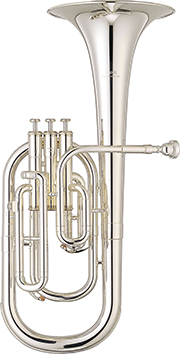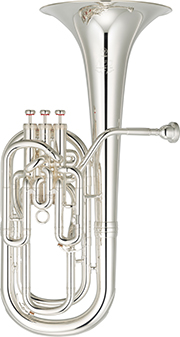The origins of the Tuba
The Family of Saxhorn Instruments
Differences between the alto horn, tenor horn, and baritone
Due to complicated circumstances, the names of saxhorn instruments vary between countries and historical periods. Explanations here will mainly focus on the instruments used in Japan, the U.K., and the U.S
Despite a list of names that includes the alto horn, tenor horn, and baritone, there are actually only two types of instruments in the saxhorn family. Some countries, however, use three or more categories for these two types of instruments. The names differ depending on the tonality or thickness of the tubes, the instrument's timbre, and its function in a band.
The alto horn
This is an E♭ tuba five tones lower than a trumpet and is sometimes played by trumpeters or horn players. Called the alto horn in Japan and the U.S., it is referred to as the tenor horn in the U.K.

The alto horn
The tenor horn
As mentioned above, this is called the alto horn in Japan and the U.S. In the U.K., however, it is referred to as the tenor horn. Occasionally, the same name is used in the U.S. to refer to the baritone (described below).
Also, in Germany, the name tenor horn can describe an instrument of an entirely different shape. If you hear "tenor horn" in Japan, it may refer to this German instrument.
The baritone
Usually equipped with three piston valves, this B♭ horn has the same tonal range as the euphonium. Some euphonium and trombone players will also play the baritone.
The timbre is bright and the tubes are considerably thinner than the euphonium. Despite having tubes thinner than the euphonium, the B♭ horn is called the baritone.
In the U.S., a euphonium with the bell and pistons facing forward may be called a baritone to differentiate it from a true euphonium.

The baritone
Musical Instrument Guide:Tuba Contents
Origins
Structure
How to Play
How the Instrument is Made
Choosing an Instrument
Trivia
- A Massive Tuba from 100 Years Ago
- Depending on the Country, a Baritone is Not a Baritone
- The Cinbasso-Popular in Italian Opera
- All Brass Instruments Have Marching Band Models
- Famous Musical Pieces for the Tuba (Bass)
- The Compensating System for the Euphonium
- There are Various Mutes for the Tuba
- Ease of Playing Pedal Tones
- Why Are Tubas So Expensive?
- Do Jazz Musicians Play the Tuba?
- Brass Band Songs Featuring the Tuba
- An Instrument in the Key of B♭, Yet the Music is Written in C
